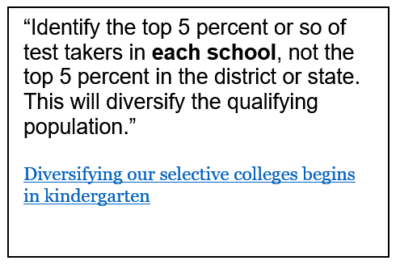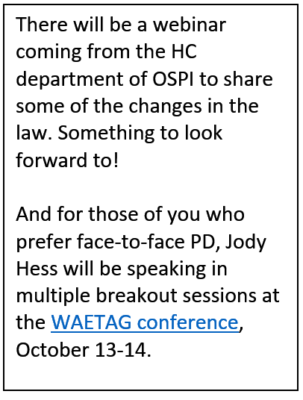I spent several days this summer at the annual board retreat for WAETAG (Washington Association of Educators of Talents and Gifted). Jody Hess, OSPI’s Program Supervisor for Highly Capable Student Programs, came to talk with us about a change to the law: districts must “prioritize equitable identification of low income students.”
One of the barriers to equity in HC programs is the process districts use to invite students into the identification procedure. I was stunned to learn this year how many districts still use nominations as an initial screening device.
What’s the problem with that?
There is still a great deal of confusion about the nature of the Highly Capable or gifted student. Many people—teachers and parents—nominate only those students who are responsible, high-achieving, engaged, motivated, and well-behaved. They fail to nominate students who never turn in their assignments, resist doing any class work, are distracted, and chronically misbehave, even if those less than stellar scholars meet the state criteria for identification.
Then there’s a thornier issue. It seems that people do a better job at nominating students who are similar to them—the same ethnic background, the same socio-economic background. If a majority of teachers in a district are white and middle class, it’s possible HC minority and lower socio-economic students in that district may be overlooked.
If teachers don’t nominate a student, the parents can always fill out a nomination form, right? Trouble is, relying on parents to nominate their children is always tricky. Some parents are savvier than others. Is it fair to make a child’s chance at identification rest on their parents’ ability to access and maneuver around the system?
The solution is called universal screening. ALL the students in the district are tested for the Highly Capable program. Or at least use a quick screener (it might be test or checklist such as WaKIDS) with all students initially. Then include those students who score well in a pool for more formal identification.
By the way, universal screening also means there is no impediment to the testing. For example, the testing isn’t offered only on Saturday when some families might not be able to bring their child.
At my district we test every student at the end of second grade. The tests are conducted during the school day, and they are administered in the second grade classrooms by the students’ own teachers. There is very little test anxiety in that situation. We’ve been doing our testing this way for about 15 years now. I honestly thought by now it was standard operating procedure around the state.
If you don’t see every student in your district having some screening for your HC program, you should start asking why.
Multiple Points of Data
Another question you want to ask is if your district is relying on a single criterion for identification: a CogAT score, for example.
While a CogAT is a great way to say, “Yes, this child definitely needs services through the Highly Capable Program,” too often a slightly lower score is used as an excuse to say, “No, this child definitely does not need services.”
No district should be using cut off scores—those in the 95%ile and above are eligible and get served, those below aren’t and don’t, and we’re done.
Instead districts should be looking at multiple data points. It’s fine to say that children who score at 130 and above obviously need services. Now it’s time to look more closely at the children who don’t quite make that. How do they score on achievement tests? On their SBA? On report cards?
When the Multi-disciplinary Team at my district meets to work on Highly Capable identifications, we have access to many types of data, including:
- CogAT scores (broken down so we can see verbal, quantitative, and nonverbal scores),
- STAR math and reading (we can access STAR scores for the year so we can track the progression of scores),
- SBA (for grade levels that took the test),
- parent and teacher nominations (which still get turned in even though they are not required), and
- HOPE scale scores (from teachers).
 Other information we have is ELL status of students. Our district ELL coordinator is a member of the team and keeps us up-to-date about how ELL students on our lists are progressing. We take that information into account when making decisions. We attempt to keep the identification for HC proportional with the demographics of the district.
Other information we have is ELL status of students. Our district ELL coordinator is a member of the team and keeps us up-to-date about how ELL students on our lists are progressing. We take that information into account when making decisions. We attempt to keep the identification for HC proportional with the demographics of the district.
For students going into grades 3-5, we first look for students whose scores are so high in both verbal and quantitative areas that they belong in the self-contained HC classes. We don’t limit ourselves to just the CogAT scores to determine which students require those advanced services. Then we go through the lists again. If there are students who are strong in math or verbal, we identify them in those particular areas for extra attention in their general education classrooms.
We are looking for reasons TO identify students, not reasons to deny services.
In middle school every fifth grade student’s math scores in the district are analyzed and every student is placed in math according to their abilities. There are sixth graders in middle school this year taking sixth grade math, seventh grade math, algebra, and geometry.
(When I first arrived in my district the math department at the middle schools would not allow a student to take algebra before eighth grade. “They aren’t developmentally ready.” Now we have sixth graders taking geometry!)
Students who were in the self-contained fifth grade class, students who were identified for verbal skills in elementary school, and additional students whose parents or teachers request that they get retested at the end of fifth grade can all move into the HC English/social studies classes at the middle school. We have one full class at one middle school and
two full classes at the other. Then at the high school all students have access to pre-AP and AP starting at ninth grade.

Low Income
The trouble with saying we have to “prioritize equitable identification of low-income students” is that we can’t know which of our students are low-income. Not when
we go into the Multi-disciplinary Team meetings and look at data. After all, we aren’t allowed to have individual students identified as free/reduced lunch.
(Jody Hess from OSPI is working on what indicators of low-income may be useful, without “profiling” students.)
The point it, we have to do the best we can at identifying every student who needs services. And then provide those services.
I LOVE how you explained this piece by piece–and all the concerns with equity and access. Thank you for laying it out so clearly.
Great article, and very timely as we prepare to discuss this topic in several sessions at WAETAG 2017. In addition to the equity issue, I wonder about the verbiage used. I believe the term for seeking services should be through a referral, not a nomination. We are referring students for a service, not nominating them for a prize, as is the current connotation.